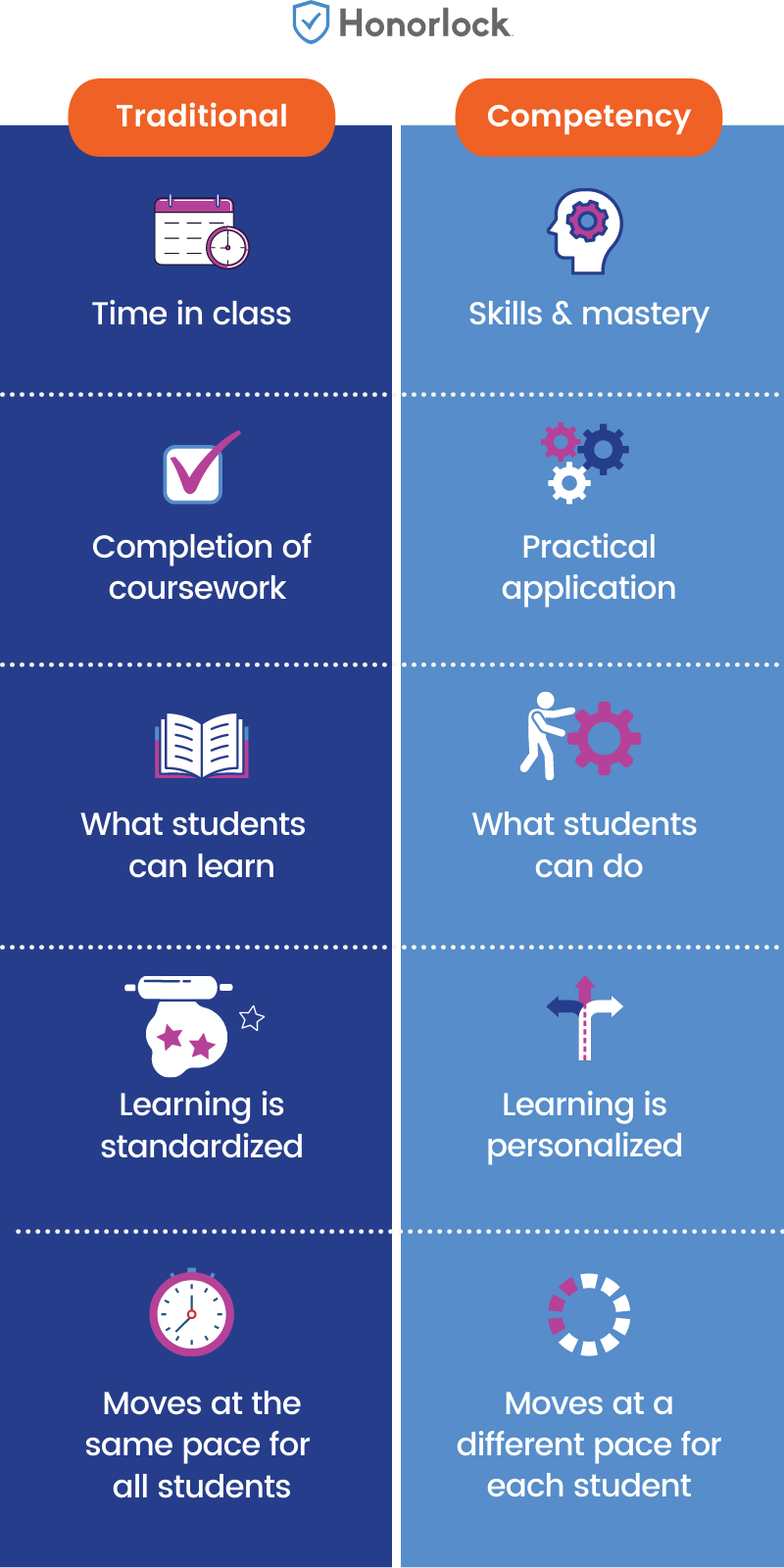This blog will show you:
- What competency-based education is
- The benefits of competency-based education for distance learning
- A chart comparing the differences between competency-based learning and traditional education
This blog isn’t meant to determine whether CBE or traditional learning is a better style of teaching and learning. The goal of this blog is to show the differences between the two styles and to highlight the benefits of CBE in remote learning
What are the Benefits of Competency-Based Education in Online Learning?
Here are 9 ways CBE benefits online learning:
- Improving student engagement and learning outcomes
- Preparing students for real-world situations
- Providing an equitable learning experience and removing bias
- Requiring mastery and application before advancing
- Allowing students to progress at their own pace
- Personalizing learning paths
- Testing knowledge and mastery through progressive, meaningful assessments
- Benefitting remote learning and in-person classes
- Gathering applicable feedback and insights about student progress
What is Competency-Based Education?
Competency-based education allows students to show what they know and what they can do instead of focusing on the number of hours spent in the classroom. Students progress through the course at their own pace and only advance after showing mastery and practical application.
What’s a competency?
The US Department of Education defines a competency as a “combination of skills, abilities, and knowledge needed to perform a specific task.”
CBE is a different approach that’s slowly growing
Competency-based teaching is growing and gradually being adopted by more and more institutions.
A 2020 survey of nearly 500 higher education institutions found that:
- 13% already have full CBE programs in place
- 47% are in the process of implementing CBE
- 26% are interested in adopting CBE
“We’re seeing growth, but not seeing exponentially crazy growth. It’s growing thoughtfully and carefully and that’s what we need.” – Amy Laitinen, director for higher education at New America’s education policy program.
How does competency-based education work?
CBE starts by establishing the tasks that we want students to complete and allowing students to learn by demonstrating their knowledge, skills, and abilities.
Competency-Based Education vs Traditional Education
Here’s a list of differences between CBE and traditional education

Why is competency-based teaching important for remote learning?
CBE increases student engagement and improves learning outcomes
The following benefits in this section contribute to CBE’s ability to increase student engagement and learning outcomes. From self-paced progression and personalized learning paths to real-world practical application and meaningful exams, CBE improves the teaching and learning experience whether it’s an online course or in-person class.
“[Competency-based learning] leads to better student engagement because the content is relevant to each student and tailored to their unique needs. It also leads to better student outcomes because the pace of learning is customized to each student.” – US Department of Education
Competency-based learning prepares students for real-world situations
Mastering content is one thing but applying skills and knowledge in real-world scenarios is another. This is where competency-based learning shines because it helps prepare students for real-world situations where they’ll need to apply what they know.
Creates an equitable remote learning environment that removes bias
Equity in education doesn’t mean that all students are required to learn the same thing; it means providing each student with an equal opportunity to learn regardless of their education, skillset, condition, or background. Equity in education adapts to individual learner needs, provides access, encourages diversity, and creates a welcoming learning environment for all students.
CBE is well-positioned to improve equity and inclusion in online learning because it tailors learning paths for each student and empowers them by providing autonomy and encouraging engagement.
Students master competencies before advancing
Essentially, students must show that they’ve mastered each competency before they can move on to other materials in the online course. This helps ensure that students are fully prepared to apply what they learned at the next stage of their education.
Competency-based learning is self-paced
Some students may master a competency quickly, while others may need more time. Regardless of how long it takes, each student is equally empowered to achieve the educational objectives and progressively learn and master competencies in the online course.
CBE programs personalize learning
Competency-based programs provide students with autonomy and flexibility to progress through the online course content at their own pace. Because students can learn at their own pace and content is tailored based on their progress, competency-based education creates a personalized learning experience with multiple learning paths based on student needs.
Assessments incrementally measure knowledge and mastery
Measurable assessments with clear learning objectives are a foundational element of competency-based learning that impacts students and instructors. Competency-based assessments are an ongoing effort that builds on knowledge and skills that the student has mastered in the online course.
Competency-based education works for remote learning and in-person classes
Competency-based teaching and learning can apply to different course formats, including fully online courses, in-person classrooms, and blended learning environments. The flexibility of competency-based programs means they can also apply to most subject areas, courses, and academic programs.
Gathering better feedback and insight about student progress
Competency-based teaching and learning measures success towards learning outcomes in an objective way which provides instructors with applicable feedback and insight about student progress. Using formative assessments and other low-stakes exams provide instructors with student responses about their experience in the course and areas to improve. Along with insights from formative assessments, CBE tests show exactly where students are in their path to mastering course content and application.
Implementing competency-based education in online education takes a thoughtful approach that requires thorough planning, mindful execution, ongoing evaluation, and some patience.
Part 2: How to implement and use CBE in online classes

